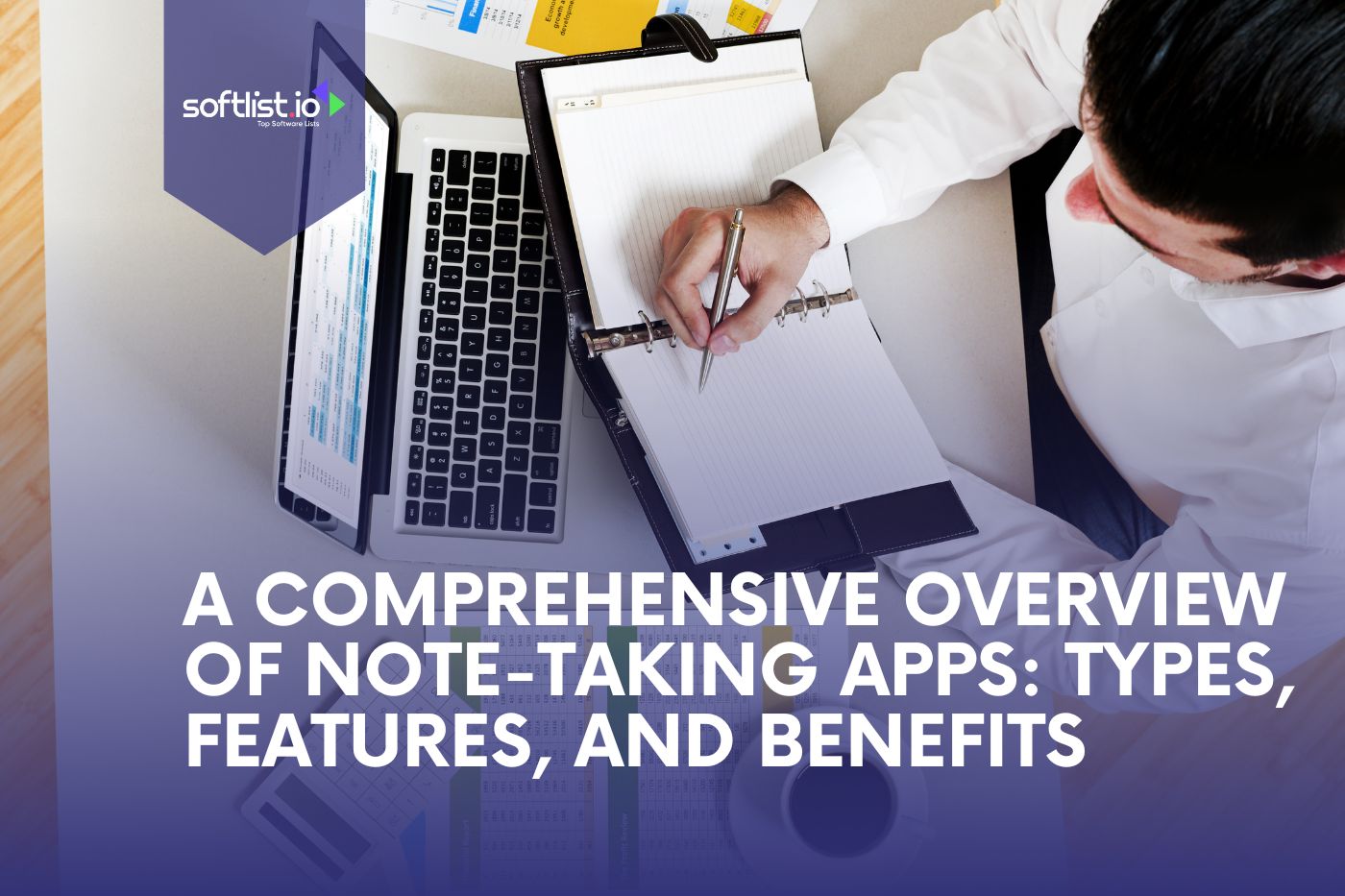Home > Blog > Note-taking Apps
Have you ever wished for a better way to organize and make sense of your notes? If yes, then note-taking apps are the way to go. With so many apps to choose from, finding the right one can seem daunting.
In this comprehensive overview, we’ll explore the different types of note-taking apps, their standout features, and the benefits they offer. Whether you’re a student, professional, or someone who loves to jot down ideas, there’s an app out there tailored to your needs.
The best part? Many of these apps automatically sync your notes across devices, ensuring you’ll never lose track of your thoughts.
What are Note-Taking Apps? Note-taking apps are digital tools that allow users to create, store, and manage notes. These notes can be in various forms: text, audio recordings, images, videos, and more. Note-taking apps are designed to help busy people stay organized and get things done.
The most common type of note-taking app allows users to add notes using their mobile devices. Some apps allow users to share their notes with others over the internet, while others are designed for personal use. Some of these apps have additional features like reminders, tags, and search functions.
These apps can be extremely helpful for students, professionals, and anyone who needs to keep track of information or tasks. For example, students can use note-taking apps to take class notes quickly and easily and access them from any device. Likewise, business professionals can use them to stay organized by taking notes during meetings or conferences or to jot down ideas for their work.
Note-taking apps are useful for preparing for exams, writing reports, scheduling events, etc. They offer quick and easy access to information that would otherwise take much time to find or remember.
Benefits of Using Note-Taking Apps Improved Organizational Skills Note-taking apps allow users to organize their notes in meaningful ways. This makes it easier to store and access notes quickly as needed.
Highlight Important Information Note-taking apps allow users to highlight important information or key passages from articles or texts, making them easier to find and review.
Easy Access to Notes With these apps, you can access notes from any device connected to the internet, so you can take your notes with you wherever you go.
Automated Backups These apps often provide automated backups of your notes, so you don’t have to worry about losing them in case of a technical issue or computer failure.
Integrations With Other Services Note-taking apps usually integrate with other popular services like Evernote and Dropbox . This allows you to easily sync up your data across multiple devices and collaborate with others on shared projects.
Types of Note-Taking Apps Text-Based Note-Taking Apps Text-based note-taking apps are digital note-keeping tools that allow users to store and organize their notes online. Unlike traditional pen and paper notes, these apps provide users with various features that make note-taking more efficient and organized. In addition, by taking advantage of the capabilities of modern technology, they give users a convenient way to capture important information quickly and easily.
Some of the features of text-based note-taking apps include creating folders for organizing data and tagging items for easy retrieval. For example, a user might create folders for topics such as “Health” or “Business” and tag each note related to those topics accordingly.
They also provide users with options to add images and hyperlinks to their notes and support for popular markup languages like Markdown, allowing them to create rich content. Some apps even integrate features from other services, such as cloud storage and productivity tools , making accessing their notes from anywhere easier.
Voice-Based Note-Taking Apps Voice-based note-taking apps provide users a convenient way to capture and store important information. They record audio notes and transcribe them into text for easy searching and referencing. These apps are particularly useful for capturing ideas quickly and accurately and recording lectures, meetings, and interviews for later review.
Features available in voice-based note-taking apps include adding tags and categorizing recordings according to topics and options to share recordings with others or export them to other platforms.
Visual-Based Note-Taking Apps Visual note-taking apps allow users to easily capture and organize their ideas using visuals such as sketches, diagrams, images, and other visual elements. Users can easily establish connections between concepts and ideas by incorporating visuals into their notes. This makes visual note-taking particularly useful when brainstorming and mapping out complex topics.
Features available in these apps include the ability to create mind maps, draw diagrams, add images and annotations, and more. Some apps even come with tools that enable users to collaborate on their visual notes in real time with other users.
How to Choose the Right Note-Taking App for You 1. Brainstorm Features You Need in a Note-Taking App The first step in determining the best note-taking app for you is brainstorming the features the app needs. When it comes to taking notes, everyone has different needs and preferences. Figure out what’s important to you before beginning your search. Here are some features that people often look for when looking for a note-taking app:
Syncing capabilities – Syncing your notes across multiple devices can be incredibly helpful. With a syncing feature, you won’t have to worry about manually transferring your notes from one device to another. Cloud Storage – With cloud storage, all your notes will be backed up and stored off-site. That way, you won’t need to worry about losing important information due to hardware malfunction or data loss.Formatting options – People like to take notes differently, so choosing from various formatting options is useful. Bold text, italics, bullets, and numbering are some formatting features most note-taking apps offer.Security features – Depending on the type of data you plan on storing in your notes, security might be your major priority. Be sure to choose an app with strong encryption and other security features. 2. Make a List of the Top 5 Apps That Meet Your Criteria There are plenty of reviews and comparison sites available that can help narrow down your options. Make sure to read through customer reviews to get a better idea of the pros and cons of each app. Additionally, try out demos or trial versions to experience the app’s user interface firsthand. This will ensure that whichever app you use has an intuitive layout and ease of use.
Once you have identified the top five apps that meet your criteria, compare and contrast their features. This will help you determine which offers the most value for the money and best suits your needs. Ultimately, this step is critical in helping you choose the right note-taking app.
3. Read Reviews and Customer Feedback to Learn More About Each Option Read reviews from real users to gain insights into the customer experience. Also, take the time to review each app’s customer support section and review customers’ inquiries and questions surrounding the app. This will give you a better picture of what other people are experiencing and how satisfied they are.
Check out online forums and discussion boards dedicated to the applications to learn what others think. This helps clear up any questions you have regarding an app and provides you with an overall picture of its functioning.
4. Compare Pricing Plans and Availability of Features Across Different Apps The features and pricing plans can drastically differ depending on your chosen app. Compare each app’s features and prices to understand better how they stack up against each other. Money should not be the only factor in your decision-making process, but it is important. Ensure all the features you need are included in the pricing plan and within your budget.
5. Consider Any Security or Privacy Concerns Associated With Each App The security and privacy of your notes should always be a priority. Check each app’s privacy policy and ensure you understand what personal data is collected and how it is used. Additionally, check for features that allow you to protect your notes with passwords or other authentication mechanisms. Consider the security and privacy features before choosing a note-taking app to ensure your data is safe and secure.
6. Decide Which of the Apps Best Matches Your Needs and Budget After researching each of the apps and comparing their features, pricing plans, and security protocols, you should be able to decide which best suits your needs and budget. Remember that other factors, such as user interface and customer support, may also play a role in determining which app to use. Ultimately, your choice should be based on the most important features to you and the one that provides the best value for money.
7. Set up a Free Trial Period for the Chosen App Once you have chosen the right note-taking app, it’s time to give it a test drive! Many apps offer a free trial period to experience the features and user interface firsthand before committing. Take advantage of this trial period to ensure the app is what you want.
8. Take Time to Test the App and Its Features to See if It Meets Your Expectations The next step in choosing the right note-taking app for you is to test the app and its features to see if it meets your expectations. Trying an app is a great way to ensure that its features match your needs and see how easy it is to use .
To test the app and its features, you should first consider how much time you will devote to testing it out. You may want to dedicate an hour or two to this process, or you might prefer to spread the testing sessions out over a few days or weeks.
Once you have determined how much time you will devote to testing, you can explore the app’s features. Make sure to look at what type of notes can be taken, how existing notes can be edited and searched, and how notes can be shared with others.
Additionally, investigate other features your chosen app may offer, such as syncing across devices or adding images, audio recordings, etc. Familiarize yourself with these features and ensure they meet your expectations.
9. Ask Friends or Colleagues for Advice on Their Note-Taking Apps If you are still trying to choose a note-taking app, asking friends or colleagues for advice can be helpful. Ask them what app they use, why, and their experience with each app. This can provide additional insights into various apps you may not have considered.
10. Make a Final Decision That Works for You, and Enjoy Taking Notes Once you have done all the research, testing, and polling of friends, it’s time to decide which app works best for you . You should be able to confidently choose the right note-taking app based on your needs and budget.
Next, read through the app’s terms and conditions before committing to ensure you understand what data is collected and how it is used. Lastly, enjoy taking notes with your chosen app!
FAQs What Are Some Key Features of Note-Taking Apps Like Evernote? Note-taking apps like Evernote offer a wide range of features, including the ability to save, summarize, scan, and organize your notes. They also provide functionalities such as file organization, creating outlines, integrating calendars, and downloading content for offline access.
How Does Evernote Make Note-Taking More Efficient? Evernote makes note-taking efficient by providing a user-friendly interface for organizing notes, updating content in real time, and syncing across all your devices. Its web clipper feature allows users to save content from the web directly into their notes for easy reference.
Can Note-Taking Apps Help with Collaboration and Communication? Yes, note-taking apps like Evernote support collaboration by allowing users to share notes, edit content in real time, and assign tasks to team members. This fosters efficient communication and streamlines the workflow for group projects or meeting notes.
How Do Note-Taking Apps Improve Productivity? Note-taking apps help improve productivity by saving time on organizing and searching for notes, prioritizing tasks with to-do lists, and automating repetitive tasks like scanning documents or summarizing content. This allows users to focus on important tasks and stay efficient.
What Is OCR and How Does It Benefit Note-Taking Apps? OCR (Optical Character Recognition) technology allows note-taking apps to recognize text within images or scanned documents, making the content searchable and editable. This feature enhances the efficiency of note-taking by converting handwritten notes into digital text.
How Can Note-Taking Apps Like Evernote Be Tailored to Individual Preferences? Note-taking apps offer customization options for users to tailor their notes, layouts, and settings according to their preferences. This flexibility allows individuals to personalize their note-taking experience and optimize their workflow.
Do Note-Taking Apps Support Real-Time Editing and Instant Recall of Information? Yes, note-taking apps provide real-time editing capabilities for multiple users to collaborate on the same document simultaneously. Additionally, users can instantly recall information from their notes using keywords or search functionalities for quick reference.
Conclusion Note-taking apps reveal a plethora of options designed to cater to diverse needs and preferences. These apps aren’t just about jotting down notes; they offer robust features like tasks, desktop integration, and even AI-powered search capabilities.
Whether you need to annotate a PDF, take meeting notes, or manage complex projects, these tools can help you take the necessary steps and assign responsibilities effectively.
The beauty of modern note-taking apps lies in their versatility. You can seamlessly switch from your desktop to mobile devices, ensuring your information is accessible anytime and anywhere. The inclusion of AI-powered search allows you to quickly find what you need, enhancing productivity and efficiency.
If you’re still unsure whether note-taking apps are for you, consider the myriad benefits they bring alongside traditional note-taking methods. Embrace the future of organization and productivity with the right note-taking app that fits your workflow and personal style.



